#Schema Management Tools
Explore tagged Tumblr posts
Text
Unity Catalog: Unlocking Powerful Advanced Data Control in Databricks
Harness the power of Unity Catalog within Databricks and elevate your data governance to new heights. Our latest blog post, "Unity Catalog: Unlocking Advanced Data Control in Databricks," delves into the cutting-edge features
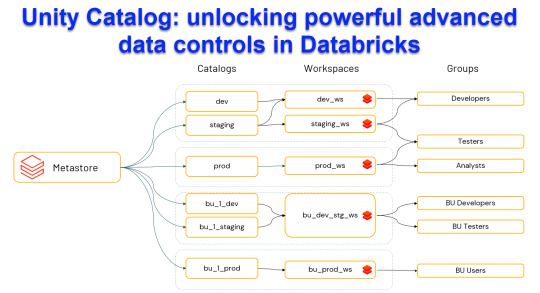
View On WordPress
#Advanced Data Security#Automated Data Lineage#Cloud Data Governance#Column Level Masking#Data Discovery and Cataloging#Data Ecosystem Security#Data Governance Solutions#Data Management Best Practices#Data Privacy Compliance#Databricks Data Control#Databricks Delta Sharing#Databricks Lakehouse Platform#Delta Lake Governance#External Data Locations#Managed Data Sources#Row Level Security#Schema Management Tools#Secure Data Sharing#Unity Catalog Databricks#Unity Catalog Features
0 notes
Text
Top Digital Marketing Strategies for 2025

1. AI-Driven SEO & Content Marketing
Search engines are evolving, with AI-powered algorithms reshaping how content ranks. To maintain a competitive edge: ✅ Prioritise Experience, Expertise, Authority, and Trustworthiness (E-E-A-T) when creating content. ✅ Utilise AI-based tools like Jasper, SurferSEO, and Frase.io for content optimisation. ✅ Focus on long-form, informative content tailored to user intent. ✅ Implement structured data and schema markup to improve search visibility. ✅ Optimise for voice search and AI-generated responses to align with new search behaviours.
2. Hyper-Personalised Marketing

Consumers expect customised experiences across all digital platforms. To meet this demand: ✅ Use AI-powered customer relationship management (CRM) tools such as HubSpot, Klaviyo, and ActiveCampaign for audience segmentation. ✅ Personalise email campaigns with dynamic content and behaviour-based automation. ✅ Leverage Google Ads Performance Max and Meta’s AI-driven targeting for precise ad placements. ✅ Incorporate personalised product recommendations for eCommerce and digital shopfronts.
3. Short-Form & Interactive Video Content
Video remains a dominant force in digital marketing, particularly short, engaging formats: ✅ Create content for TikTok, Instagram Reels, and YouTube Shorts to capture audience attention quickly. ✅ Utilise AI-powered video creation platforms like Synthesia, RunwayML, and Pictory. ✅ Integrate interactive elements such as polls, quizzes, and live Q&A sessions to drive engagement. ✅ Experiment with immersive experiences like 360-degree videos and augmented reality (AR).
4. Performance-Driven Paid Advertising

Data-driven advertising is becoming smarter and more efficient: ✅ Use AI-powered Google and Meta Ads for automated bidding and precise targeting. ✅ Implement retargeting strategies to reconnect with past visitors. ✅ Leverage AI analytics to anticipate user behaviour and optimise conversion rates. ✅ Adopt programmatic advertising for automated, real-time ad placements.
5. Influencer & User-Generated Content (UGC) Marketing
Influencer marketing is shifting towards authenticity and community engagement: ✅ Partner with micro and nano influencers to achieve higher engagement at lower costs. ✅ Encourage UGC through branded challenges, reviews, and community hashtags. ✅ Use AI tools to evaluate influencer reach and engagement rates. ✅ Feature UGC across websites, social platforms, and email marketing for credibility.
6. Community & Conversational Marketing

Building digital communities fosters brand loyalty and customer retention: ✅ Engage with audiences on WhatsApp, Telegram, and Discord. ✅ Deploy AI chatbots for real-time customer interactions and automated lead nurturing. ✅ Host live events, such as webinars and Q&A sessions, to strengthen brand relationships. ✅ Implement SMS marketing and AI-driven chat to provide personalised communication.
7. Ethical & Sustainable Marketing
Consumers increasingly value sustainability and ethical business practices: ✅ Promote eco-friendly products and sustainable packaging in digital campaigns. ✅ Share corporate social responsibility (CSR) initiatives through storytelling. ✅ Adopt privacy-focused marketing strategies, including ethical data collection and zero-party data. ✅ Be transparent about sourcing, brand values, and business ethics.
8. Web3 & Blockchain in Marketing

Decentralised technologies are reshaping digital marketing strategies: ✅ Explore NFT-based loyalty programs to drive engagement. ✅ Utilise decentralised social media for better audience ownership. ✅ Implement blockchain for transparency in advertising and fraud prevention. ✅ Accept cryptocurrency payments for online services and eCommerce transactions.
9. AI-Powered Data Analytics & CRO
Data-driven decision-making enhances marketing performance: ✅ Use Google Analytics 4 (GA4), Hotjar, and Crazy Egg to analyse user behaviour. ✅ Conduct A/B testing on landing pages, emails, and ads for optimisation. ✅ Leverage predictive analytics to identify trends and customer preferences. ✅ Improve website UX and sales funnels to increase conversions.
10. Voice & Visual Search Optimisation

As voice and visual search continue to grow, businesses must adapt: ✅ Optimise content for natural language and voice search queries. ✅ Implement image and video search SEO using Google Lens and Pinterest Visual Search. ✅ Enhance accessibility with alt text, metadata, and structured product descriptions. ✅ Focus on multimedia-rich content to align with AI-driven search results.
🔥 Final Thoughts
To stay competitive in 2025, brands must embrace AI, automation, and data-driven strategies while maintaining an authentic connection with their audience. Businesses that leverage new technologies while prioritising customer experience will stand out in the evolving digital space.
📌 Read more insights at: 👉 check out
4 notes
·
View notes
Text
The Great Data Cleanup: A Database Design Adventure
As a budding database engineer, I found myself in a situation that was both daunting and hilarious. Our company's application was running slower than a turtle in peanut butter, and no one could figure out why. That is, until I decided to take a closer look at the database design.
It all began when my boss, a stern woman with a penchant for dramatic entrances, stormed into my cubicle. "Listen up, rookie," she barked (despite the fact that I was quite experienced by this point). "The marketing team is in an uproar over the app's performance. Think you can sort this mess out?"
Challenge accepted! I cracked my knuckles, took a deep breath, and dove headfirst into the database, ready to untangle the digital spaghetti.
The schema was a sight to behold—if you were a fan of chaos, that is. Tables were crammed with redundant data, and the relationships between them made as much sense as a platypus in a tuxedo.
"Okay," I told myself, "time to unleash the power of database normalization."
First, I identified the main entities—clients, transactions, products, and so forth. Then, I dissected each entity into its basic components, ruthlessly eliminating any unnecessary duplication.
For example, the original "clients" table was a hot mess. It had fields for the client's name, address, phone number, and email, but it also inexplicably included fields for the account manager's name and contact information. Data redundancy alert!
So, I created a new "account_managers" table to store all that information, and linked the clients back to their account managers using a foreign key. Boom! Normalized.
Next, I tackled the transactions table. It was a jumble of product details, shipping info, and payment data. I split it into three distinct tables—one for the transaction header, one for the line items, and one for the shipping and payment details.
"This is starting to look promising," I thought, giving myself an imaginary high-five.
After several more rounds of table splitting and relationship building, the database was looking sleek, streamlined, and ready for action. I couldn't wait to see the results.
Sure enough, the next day, when the marketing team tested the app, it was like night and day. The pages loaded in a flash, and the users were practically singing my praises (okay, maybe not singing, but definitely less cranky).
My boss, who was not one for effusive praise, gave me a rare smile and said, "Good job, rookie. I knew you had it in you."
From that day forward, I became the go-to person for all things database-related. And you know what? I actually enjoyed the challenge. It's like solving a complex puzzle, but with a lot more coffee and SQL.
So, if you ever find yourself dealing with a sluggish app and a tangled database, don't panic. Grab a strong cup of coffee, roll up your sleeves, and dive into the normalization process. Trust me, your users (and your boss) will be eternally grateful.
Step-by-Step Guide to Database Normalization
Here's the step-by-step process I used to normalize the database and resolve the performance issues. I used an online database design tool to visualize this design. Here's what I did:
Original Clients Table:
ClientID int
ClientName varchar
ClientAddress varchar
ClientPhone varchar
ClientEmail varchar
AccountManagerName varchar
AccountManagerPhone varchar
Step 1: Separate the Account Managers information into a new table:
AccountManagers Table:
AccountManagerID int
AccountManagerName varchar
AccountManagerPhone varchar
Updated Clients Table:
ClientID int
ClientName varchar
ClientAddress varchar
ClientPhone varchar
ClientEmail varchar
AccountManagerID int
Step 2: Separate the Transactions information into a new table:
Transactions Table:
TransactionID int
ClientID int
TransactionDate date
ShippingAddress varchar
ShippingPhone varchar
PaymentMethod varchar
PaymentDetails varchar
Step 3: Separate the Transaction Line Items into a new table:
TransactionLineItems Table:
LineItemID int
TransactionID int
ProductID int
Quantity int
UnitPrice decimal
Step 4: Create a separate table for Products:
Products Table:
ProductID int
ProductName varchar
ProductDescription varchar
UnitPrice decimal
After these normalization steps, the database structure was much cleaner and more efficient. Here's how the relationships between the tables would look:
Clients --< Transactions >-- TransactionLineItems
Clients --< AccountManagers
Transactions --< Products
By separating the data into these normalized tables, we eliminated data redundancy, improved data integrity, and made the database more scalable. The application's performance should now be significantly faster, as the database can efficiently retrieve and process the data it needs.
Conclusion
After a whirlwind week of wrestling with spreadsheets and SQL queries, the database normalization project was complete. I leaned back, took a deep breath, and admired my work.
The previously chaotic mess of data had been transformed into a sleek, efficient database structure. Redundant information was a thing of the past, and the performance was snappy.
I couldn't wait to show my boss the results. As I walked into her office, she looked up with a hopeful glint in her eye.
"Well, rookie," she began, "any progress on that database issue?"
I grinned. "Absolutely. Let me show you."
I pulled up the new database schema on her screen, walking her through each step of the normalization process. Her eyes widened with every explanation.
"Incredible! I never realized database design could be so... detailed," she exclaimed.
When I finished, she leaned back, a satisfied smile spreading across her face.
"Fantastic job, rookie. I knew you were the right person for this." She paused, then added, "I think this calls for a celebratory lunch. My treat. What do you say?"
I didn't need to be asked twice. As we headed out, a wave of pride and accomplishment washed over me. It had been hard work, but the payoff was worth it. Not only had I solved a critical issue for the business, but I'd also cemented my reputation as the go-to database guru.
From that day on, whenever performance issues or data management challenges cropped up, my boss would come knocking. And you know what? I didn't mind one bit. It was the perfect opportunity to flex my normalization muscles and keep that database running smoothly.
So, if you ever find yourself in a similar situation—a sluggish app, a tangled database, and a boss breathing down your neck—remember: normalization is your ally. Embrace the challenge, dive into the data, and watch your application transform into a lean, mean, performance-boosting machine.
And don't forget to ask your boss out for lunch. You've earned it!
8 notes
·
View notes
Text
Top WordPress Plugins to Supercharge Your Website in 2024

Building and maintaining a WordPress site is both exciting and challenging. While the platform provides a robust foundation, the true power of WordPress lies in its plugins. From enhancing site functionality to improving user experience, WordPress plugins are indispensable tools for developers, businesses, and bloggers alike. In this blog, we’ll explore the best WordPress plugins that can transform your website into a highly functional, user-friendly, and SEO-optimized powerhouse.
What Are WordPress Plugins?
WordPress plugins are software add-ons designed to extend the functionality of your WordPress site. Whether you need to improve site speed, enhance SEO, secure your website, or add unique design features, there’s likely a plugin for that. Plugins allow both beginners and advanced users to customize their sites without coding expertise.
With over 60,000 plugins available on the WordPress Plugin Directory alone, the options can feel overwhelming. Choosing the right plugins for your website’s goals is critical for success. Below, we’ve rounded up some of the most essential WordPress plugins to consider.
Must-Have WordPress Plugins for Every Website
1. Yoast SEO
SEO is crucial for driving organic traffic to your site, and Yoast SEO is one of the best tools for optimizing your content. This plugin provides on-page optimization tips, readability analysis, and technical SEO tools to help your site rank higher on search engines.
2. Elementor
Looking to build a visually stunning website without hiring a designer? Elementor is a drag-and-drop page builder that makes designing websites easy. Its intuitive interface and vast array of widgets allow you to create professional-looking pages in minutes.
3. WPForms
For websites that rely on user interaction, a contact form is a must-have feature. WPForms allows you to create customizable, mobile-responsive forms effortlessly. Whether it’s contact forms, surveys, or payment forms, this plugin has you covered.
4. WooCommerce
If you’re running an online store, WooCommerce is the go-to plugin. It transforms your WordPress site into a fully functional e-commerce platform, complete with features for product listings, payment gateways, and inventory management.
5. Akismet Anti-Spam
Spam comments can clutter your website and ruin user experience. Akismet Anti-Spam automatically filters out spam comments, keeping your site clean and professional.
6. Jetpack
Created by Automattic, the team behind WordPress, Jetpack is a multipurpose plugin offering features like performance optimization, security, site analytics, and social media integration.
7. Rank Math
Another excellent SEO plugin, Rank Math provides advanced features like schema integration, keyword tracking, and detailed analytics. It’s an excellent alternative to Yoast SEO for more advanced users.
8. UpdraftPlus
Backup and restoration are critical for any website. UpdraftPlus allows you to schedule automatic backups and store them securely on cloud services like Google Drive or Dropbox.
9. Smush
Site speed plays a major role in user experience and search engine rankings. Smush compresses images without compromising quality, helping your site load faster.
10. MonsterInsights
Understanding how visitors interact with your site is essential. MonsterInsights integrates Google Analytics directly into your WordPress dashboard, offering real-time insights into traffic, user behavior, and more.
11. W3 Total Cache
Slow-loading websites lose visitors and revenue. W3 Total Cache improves website performance by caching static files and optimizing server resources.
12. Sucuri Security
Cybersecurity is non-negotiable in today’s digital landscape. Sucuri Security offers malware scanning, firewall protection, and blacklist monitoring to keep your site secure.
13. Social Snap
Boost social media engagement with Social Snap, a powerful social sharing plugin. It offers customizable sharing buttons and in-depth analytics to track your social media performance.
14. Litespeed Cache
For websites hosted on LiteSpeed servers, LiteSpeed Cache is a high-performance optimization plugin that enhances speed and reduces server load.
15. TablePress
If your site needs to display complex data, TablePress is a lifesaver. It lets you create and manage tables without requiring any coding knowledge.
Why Use WordPress Plugins?
Enhanced Functionality: WordPress plugins extend the capabilities of your site, making it easier to achieve your goals.
Ease of Use: Many plugins are beginner-friendly and require no technical expertise.
Scalability: Whether you’re running a blog, an e-commerce store, or a portfolio, plugins grow with your needs.
Cost-Effective: Most plugins offer free versions with premium features, making them accessible for all budgets.
Tips for Choosing the Right WordPress Plugins
Identify Your Needs: Start by determining what features your site requires.
Check Reviews and Ratings: Plugins with high ratings and positive reviews are generally more reliable.
Update Frequency: Look for plugins that are updated regularly to ensure compatibility with the latest WordPress version.
Avoid Overloading: Too many plugins can slow down your site. Stick to essential ones.
Final Thoughts
WordPress plugins are the backbone of a successful website. By selecting the right ones, you can enhance your site’s functionality, user experience, and performance. Whether you’re aiming to boost your SEO, secure your site, or create stunning designs, there’s a plugin tailored for your needs.
Experiment with the plugins mentioned above and watch your WordPress site thrive. Remember to regularly review your plugin list and update them to ensure optimal performance.
4 notes
·
View notes
Text
Nurturing Healing: The Profound Impact of Therapy on Managing Borderline Personality Disorder (BPD)
Hey there, fellow BPD warriors and allies! Today, let’s embark on a profound exploration of the vital role that therapy plays in our journey of managing Borderline Personality Disorder (BPD).
Living with BPD often feels like navigating a tempestuous sea, where emotions crash against the shores of our minds with relentless force. But amidst the storm, therapy stands as a steadfast lighthouse, guiding us towards calmer waters and brighter horizons.
At the heart of therapy lies a transformative process of self-discovery and healing.
It’s a sanctuary where we can peel back the layers of our innermost selves, revealing the raw, unfiltered truth beneath the surface.
Through introspective dialogue and empathetic guidance, we unravel the tangled threads of our past traumas, illuminating the pathways to understanding and acceptance.
As we traverse the terrain of therapy, we encounter a myriad of therapeutic modalities, each offering unique insights and tools for growth. From the structured approach of Dialectical Behaviour Therapy (DBT) to the introspective lens of Schema Therapy, we cultivate a rich tapestry of coping mechanisms and self-regulation skills. Through experiential exercises, role-playing, and mindfulness practices, we learn to navigate the ebb and flow of our emotions with grace and resilience.
Yet, therapy is far more than a mere journey into the depths of our psyche.
It’s a dynamic exchange between therapist and client, grounded in trust, compassion, and mutual respect.
Within this sacred space, we find solace in the knowledge that our struggles are met with unwavering empathy, free from the weight of judgment or stigma.
As we traverse the terrain of therapy, we encounter a myriad of therapeutic modalities, each offering unique insights and tools for growth. Among the most commonly used therapies for managing BPD are:
Dialectical Behaviour Therapy (DBT): DBT is a structured form of therapy that focuses on building skills in four key areas: mindfulness, distress tolerance, emotion regulation, and interpersonal effectiveness. It helps us learn to identify and change harmful behaviours, cope with intense emotions, and improve our relationships.
Schema Therapy: Schema Therapy delves into the deeply rooted patterns and beliefs that underlie our emotional struggles. By identifying and challenging maladaptive schemas—core themes about ourselves and the world—we can cultivate healthier ways of thinking, feeling, and relating to others.
Cognitive Behavioural Therapy (CBT): CBT targets the negative thought patterns and behaviours that contribute to our emotional distress. Through cognitive restructuring and behaviour modification techniques, we learn to challenge distorted thinking, develop coping strategies, and create positive change in our lives.
Psychodynamic Therapy: Psychodynamic therapy explores the unconscious conflicts and dynamics that shape our emotions and behaviours. By examining early life experiences and relationship patterns, we gain insight into the root causes of our struggles and work towards resolving unresolved issues.
Mindfulness-Based Therapies: Mindfulness-based approaches, such as Acceptance and Commitment Therapy (ACT) and Mindfulness-Based Cognitive Therapy (MBCT), emphasise present-moment awareness and nonjudgmental acceptance of our experiences. These practices help us cultivate inner peace, resilience, and self-compassion.
Yet, let’s not sugarcoat the reality:
therapy can be arduous, confronting, and downright messy at times.
We may stumble upon buried memories, confront the shadows of our past, or grapple with the weight of unspoken truths. In these moments of vulnerability, we find the courage to confront our inner demons, knowing that true healing lies on the other side of our fears.
Moreover, the journey of therapy isn’t confined to the walls of a therapist’s office; it extends into the fabric of our daily lives. Through homework assignments, journaling prompts, and real-world applications, we integrate the lessons of therapy into our everyday experiences, transforming theory into practice and insight into action.
In essence, therapy offers us a compass for navigating the complexities of BPD—a guiding light amidst the darkness, a beacon of hope in times of uncertainty. So, to all my fellow travellers on this winding road of healing, let’s honour the transformative power of therapy in our lives and embrace the journey with open hearts and unwavering resolve.
#therapy#bpd support#bpd#bpd safe#bpd thoughts#psychology#bettersoonx#community support#emotional wellness#mental health#self care#actually bpd#bpd vent#actually borderline#fp bpd#bpd journey
8 notes
·
View notes
Text
Advanced SEO Techniques to Drive Organic Growth in 2024
Introduction In the competitive world of digital marketing, staying ahead in SEO requires more than basic on-page optimizations and link building. As search engines evolve, advanced SEO strategies become critical for maintaining and increasing visibility. This article dives into advanced SEO techniques to enhance your organic reach and keep you at the forefront of search engine results in 2024.
Optimize for User Intent: Beyond Keywords Understand the Four Types of User Intent: Informational, Navigational, Transactional, and Commercial. Craft content that addresses these specific intents.
Use Semantic Search & Natural Language: Google's understanding of language has improved, focusing on topics rather than exact keywords. Use synonyms and related terms naturally within content. Focus on Long-Tail Keywords: While short keywords are competitive, long-tail keywords often align better with specific user intent and are easier to rank for.
Advanced Content Structuring and Clustering Topic Clustering: Group related content into clusters with a central 'pillar' page. For instance, if you’re in digital marketing, a central "Advanced SEO Techniques" page can link to clusters on user intent, technical SEO, link-building tactics, etc.
Internal Linking Optimization: Strategically link cluster content back to the main page and vice versa. This structure signals relevance to search engines, boosting the authority of your core content.
Schema Markup: Implement structured data for rich snippets. Schema helps search engines understand the context, which can lead to enhanced visibility (like FAQ snippets or How-to sections).
Harnessing AI and Machine Learning for Content Strategy Use AI to Identify Content Gaps: Tools like MarketMuse, Clearscope, and SurferSEO analyze competitors’ content, helping you find and cover gaps. Leverage Predictive Analytics: Platforms like Google Analytics and other SEO tools can help predict trends. By focusing on future keywords and trends, you can stay ahead of competitors.
Content Personalization: With AI, you can deliver personalized content based on user behavior. Tailor CTAs and recommendations based on each user's interaction history.
Technical SEO Enhancements Site Speed Optimization: A fast site is essential. Use Core Web Vitals as a benchmark, and optimize images, reduce server response time, and implement lazy loading.
Crawl Budget Optimization: Ensure that only important pages are crawled by managing noindex tags and removing unnecessary pages (like duplicates).
Advanced Mobile SEO: With Google’s mobile-first indexing, having a fully optimized mobile site is vital. Test and improve responsiveness, mobile page speed, and usability.
Enhanced Backlinking Strategies Authority & Relevancy: Focus on getting links from high-authority, niche-relevant sites rather than generic links. Digital PR and Brand Mentions: Engage in PR campaigns that result in media mentions, which indirectly enhance SEO through brand visibility and trust.
Guest Posting 2.0: Instead of traditional guest posting, collaborate on in-depth studies or expert roundup articles, which naturally attract backlinks and add credibility.
Optimizing for Voice Search and Visual Search Voice Search SEO: Focus on answering “Who, What, Where, When, and How” questions directly. Optimize for natural-sounding, conversational phrases. Visual Search: Ensure images are optimized with descriptive, relevant filenames and alt text. Use image sitemaps to help Google discover your images. Rich Media Content: Video and audio content is becoming a major part of SEO. Hosting transcribed podcasts or adding video summaries can cater to different audience preferences.
User Experience (UX) Signals as a Ranking Factor Optimize Core Web Vitals: Google emphasizes page experience. Improving metrics like Largest Contentful Paint (LCP), First Input Delay (FID), and Cumulative Layout Shift (CLS) can improve rankings. Reduce Bounce Rate and Dwell Time: Engage visitors by enhancing readability and structuring content for skimming. Break up content with headers, bullet points, and visuals. UX Design and Interactivity: Create a seamless user journey with an intuitive, interactive, and easy-to-navigate website.
Focus on E-E-A-T (Experience, Expertise, Authoritativeness, Trustworthiness) Author and Site Authority: Create a detailed author bio and ensure content on your site is credible and reliable. Regularly Update Content: Fresh, accurate content is crucial, particularly in YMYL (Your Money, Your Life) niches. Build Trust Signals: Showcasing testimonials, case studies, and credentials can boost trustworthiness. Conclusion With Google and other search engines continuously refining algorithms, advanced SEO techniques are essential to remain visible and relevant. By focusing on user intent, optimizing your site structure, leveraging AI, and enhancing the user experience, you can maintain a competitive edge. Implementing these advanced SEO tactics will not only boost your search rankings but also improve your audience’s experience, leading to sustained organic growth in 2024.
This post can be further customized by adding more specific tips or examples, depending on your target audience and their familiarity with these advanced concepts. Let me know if you need adjustments or if you'd like more in-depth details on any of these sections!
2 notes
·
View notes
Text
Best SEO tools
Yoast SEO Yoast SEO is a powerful WordPress tool that optimizes websites for better search engine performance, enhancing visibility and helping achieve higher Google rankings. It streamlines the SEO process, making it straightforward to increase site reach and ranking potential.
Key Functions of Yoast SEO
On-Page SEO Analysis Yoast offers real-time on-page SEO analysis, suggesting improvements for keyword density, meta descriptions, titles, and headings. This helps in refining content for better SEO.
Readability Analysis The Readability Analysis feature makes content more engaging and user-friendly by recommending improvements to sentence structure and paragraph length.
Meta Tags & Snippet Optimization Yoast allows you to create custom meta tags and snippet previews, boosting click-through rates by optimizing how your content appears in search results.
XML Sitemaps Yoast automatically generates an XML sitemap, helping search engines easily discover and index your site content.
Schema Markup This feature provides easy integration of schema types like articles, business info, and events, resulting in rich snippets that improve user engagement.
Canonical URLs Canonical URLs help manage duplicate content, which is essential for better indexing and SEO performance.
Breadcrumbs Control Yoast’s breadcrumb feature enhances navigation, lowers bounce rates, and improves SEO by organizing content hierarchy.
Social Media Integration By adding Open Graph Metadata, Yoast optimizes content for platforms like Facebook, LinkedIn, and Twitter, improving visibility and engagement.
WooCommerce WooCommerce is a versatile, open-source e-commerce platform for WordPress, ideal for all business sizes. It offers customizable online stores, secure transactions, and powerful SEO features to enhance product visibility.
Key Functions of WooCommerce
Easy Setup & Customizable Products WooCommerce’s user-friendly setup allows quick store launch, with options for digital, grouped, or physical products to suit varied customer needs.
Payment Gateway Integration Supports multiple payment types like credit cards, PayPal, and Stripe, providing a seamless checkout experience.
Inventory & Shipping Management Inventory tracking and flexible shipping options make it easy to manage stock and meet diverse customer demands.
Tax Management Automated tax calculations simplify compliance with location-based tax rates.
Extensions & Mobile-Friendly Design WooCommerce offers various extensions and themes for store customization, with a mobile-friendly design to ensure a seamless experience across devices.
Here’s a refined draft that highlights your team’s expertise, affordable pricing, and experience in Yoast SEO and WooCommerce. I’ve organized the information to reflect your strengths and service offerings in a client-focused format. Reach out to us by clicking here

#wordpress#web design#website#ecommerce website development#e commerce#web development#seo services#seo#digitalmarketing#smm#marketingtrends#emailmarketing#malware
2 notes
·
View notes
Text
Top 5 Selling Odoo Modules.
In the dynamic world of business, having the right tools can make all the difference. For Odoo users, certain modules stand out for their ability to enhance data management and operations. To optimize your Odoo implementation and leverage its full potential.
That's where Odoo ERP can be a life savior for your business. This comprehensive solution integrates various functions into one centralized platform, tailor-made for the digital economy.
Let’s drive into 5 top selling module that can revolutionize your Odoo experience:
Dashboard Ninja with AI, Odoo Power BI connector, Looker studio connector, Google sheets connector, and Odoo data model.
1. Dashboard Ninja with AI:
Using this module, Create amazing reports with the powerful and smart Odoo Dashboard ninja app for Odoo. See your business from a 360-degree angle with an interactive, and beautiful dashboard.
Some Key Features:
Real-time streaming Dashboard
Advanced data filter
Create charts from Excel and CSV file
Fluid and flexible layout
Download Dashboards items
This module gives you AI suggestions for improving your operational efficiencies.
2. Odoo Power BI Connector:
This module provides a direct connection between Odoo and Power BI Desktop, a Powerful data visualization tool.
Some Key features:
Secure token-based connection.
Proper schema and data type handling.
Fetch custom tables from Odoo.
Real-time data updates.
With Power BI, you can make informed decisions based on real-time data analysis and visualization.
3. Odoo Data Model:
The Odoo Data Model is the backbone of the entire system. It defines how your data is stored, structured, and related within the application.
Key Features:
Relations & fields: Developers can easily find relations ( one-to-many, many-to-many and many-to-one) and defining fields (columns) between data tables.
Object Relational mapping: Odoo ORM allows developers to define models (classes) that map to database tables.
The module allows you to use SQL query extensions and download data in Excel Sheets.
4. Google Sheet Connector:
This connector bridges the gap between Odoo and Google Sheets.
Some Key features:
Real-time data synchronization and transfer between Odoo and Spreadsheet.
One-time setup, No need to wrestle with API’s.
Transfer multiple tables swiftly.
Helped your team’s workflow by making Odoo data accessible in a sheet format.
5. Odoo Looker Studio Connector:
Looker studio connector by Techfinna easily integrates Odoo data with Looker, a powerful data analytics and visualization platform.
Some Key Features:
Directly integrate Odoo data to Looker Studio with just a few clicks.
The connector automatically retrieves and maps Odoo table schemas in their native data types.
Manual and scheduled data refresh.
Execute custom SQL queries for selective data fetching.
The Module helped you build detailed reports, and provide deeper business intelligence.
These Modules will improve analytics, customization, and reporting. Module setup can significantly enhance your operational efficiency. Let’s embrace these modules and take your Odoo experience to the next level.
Need Help?
I hope you find the blog helpful. Please share your feedback and suggestions.
For flawless Odoo Connectors, implementation, and services contact us at
[email protected] Or www.techneith.com
#odoo#powerbi#connector#looker#studio#google#microsoft#techfinna#ksolves#odooerp#developer#web developers#integration#odooimplementation#crm#odoointegration#odooconnector
4 notes
·
View notes
Text
Business Potential with Data Lake Implementation: A Guide by an Analytics Consulting Company
In today’s data-driven world, businesses are inundated with massive amounts of data generated every second. The challenge lies not only in managing this data but also in extracting valuable insights from it to drive business growth. This is where a data lake comes into play. As an Analytics Consulting Company, we understand the importance of implementing a robust data lake solution to help businesses harness the power of their data.
What is a Data Lake?
A data lake is a centralized repository that allows organizations to store all their structured and unstructured data at any scale. Unlike traditional databases, which are often limited by structure and schema, a data lake can accommodate raw data in its native format. This flexibility allows for greater data exploration and analytics capabilities, making it a crucial component of modern data management strategies.
The Importance of Data Lake Implementation
For businesses, implementing a data lake is not just about storing data—it's about creating a foundation for advanced analytics, machine learning, and artificial intelligence. By capturing and storing data from various sources, a data lake enables businesses to analyze historical and real-time data, uncovering hidden patterns and trends that drive strategic decision-making.
An Analytics Consulting Company like ours specializes in designing and implementing data lake solutions tailored to the unique needs of each business. With a well-structured data lake, companies can break down data silos, improve data accessibility, and ultimately, gain a competitive edge in the market.
Key Benefits of Data Lake Implementation
Scalability: One of the most significant advantages of a data lake is its ability to scale with your business. Whether you're dealing with terabytes or petabytes of data, a data lake can handle it all, ensuring that your data storage needs are met as your business grows.
Cost-Effectiveness: Traditional data storage solutions can be expensive, especially when dealing with large volumes of data. A data lake, however, offers a cost-effective alternative by using low-cost storage options. This allows businesses to store vast amounts of data without breaking the bank.
Flexibility: Data lakes are highly flexible, supporting various data types, including structured, semi-structured, and unstructured data. This flexibility enables businesses to store data in its raw form, which can be processed and analyzed as needed, without the constraints of a predefined schema.
Advanced Analytics: With a data lake, businesses can leverage advanced analytics tools to analyze large datasets, perform predictive analytics, and build machine learning models. This leads to deeper insights and more informed decision-making.
Improved Data Accessibility: A well-implemented data lake ensures that data is easily accessible to stakeholders across the organization. This democratization of data allows for better collaboration and faster innovation, as teams can quickly access and analyze the data they need.
Challenges in Data Lake Implementation
While the benefits of a data lake are clear, implementing one is not without its challenges. Businesses must navigate issues such as data governance, data quality, and security to ensure the success of their data lake.
As an experienced Analytics Consulting Company, we recognize the importance of addressing these challenges head-on. By implementing best practices in data governance, we help businesses maintain data quality and security while ensuring compliance with industry regulations.
Data Governance in Data Lake Implementation
Data governance is critical to the success of any data lake implementation. Without proper governance, businesses risk creating a "data swamp"—a data lake filled with disorganized, low-quality data that is difficult to analyze.
To prevent this, our Analytics Consulting Company focuses on establishing clear data governance policies that define data ownership, data quality standards, and data access controls. By implementing these policies, we ensure that the data lake remains a valuable asset, providing accurate and reliable insights for decision-making.
Security in Data Lake Implementation
With the increasing volume of data stored in a data lake, security becomes a top priority. Protecting sensitive information from unauthorized access and ensuring data privacy is essential.
Our Analytics Consulting Company takes a proactive approach to data security, implementing encryption, access controls, and monitoring to safeguard the data stored in the lake. We also ensure that the data lake complies with relevant data protection regulations, such as GDPR and HIPAA, to protect both the business and its customers.
The Role of an Analytics Consulting Company in Data Lake Implementation
Implementing a data lake is a complex process that requires careful planning, execution, and ongoing management. As an Analytics Consulting Company, we offer a comprehensive range of services to support businesses throughout the entire data lake implementation journey.
Assessment and Strategy Development: We begin by assessing the current data landscape and identifying the specific needs of the business. Based on this assessment, we develop a tailored data lake implementation strategy that aligns with the company’s goals.
Architecture Design: Designing the architecture of the data lake is a critical step. We ensure that the architecture is scalable, flexible, and secure, providing a strong foundation for data storage and analytics.
Implementation and Integration: Our team of experts handles the implementation process, ensuring that the data lake is seamlessly integrated with existing systems and workflows. We also manage the migration of data into the lake, ensuring that data is ingested correctly and efficiently.
Data Governance and Security: We establish robust data governance and security measures to protect the integrity and confidentiality of the data stored in the lake. This includes implementing data quality checks, access controls, and encryption.
Ongoing Support and Optimization: After the data lake is implemented, we provide ongoing support to ensure its continued success. This includes monitoring performance, optimizing storage and processing, and making adjustments as needed to accommodate changing business needs.
Conclusion
In an era where data is a key driver of business success, implementing a data lake is a strategic investment that can unlock significant value. By partnering with an experienced Analytics Consulting Company, businesses can overcome the challenges of data lake implementation and harness the full potential of their data.
With the right strategy, architecture, and governance in place, a data lake becomes more than just a storage solution—it becomes a powerful tool for driving innovation, improving decision-making, and gaining a competitive edge.
5 notes
·
View notes
Text
How Shopify Schema Generator setup can Help Your Shopify Store Get Seen

In the bustling world of e-commerce, standing out from the competition requires more than just a visually appealing website. To ensure your Shopify store gains the visibility it deserves, integrating a Shopify Schema Generator can be a game-changer. This powerful tool can enhance your search engine optimization (SEO) efforts, ensuring your products and services are easily discoverable by potential customers. This comprehensive guide will delve into the nuances of the Shopify Schema Generator and how it can elevate your store’s presence online.
Understanding Shopify Schema
Before diving into the specifics of the Shopify Schema Generator, it’s essential to understand what schema is. Schema markup, a form of microdata, helps search engines understand the content on your website. By adding this code to your Shopify store, you enable search engines to provide more informative results to users. This can include enhanced snippets, such as product prices, availability, and reviews, directly in search engine results pages (SERPs).
The Importance of Schema Markup for Shopify Stores
The benefits of implementing schema markup in your Shopify store are manifold:
Improved Visibility: Enhanced listings in SERPs can significantly increase your click-through rates.
Better SEO Performance: Search engines like Google prioritize websites with structured data, leading to better rankings.
Increased Credibility: Providing more information directly in search results builds trust with potential customers.
How the Shopify Schema Generator Works
The Shopify Schema Generator simplifies the process of adding schema markup to your store. This tool generates the necessary code snippets that can be easily integrated into your Shopify theme, ensuring your store complies with schema standards.
Key Features of the Shopify Schema Generator
Ease of Use: The generator provides an intuitive interface, allowing users to create schema markup without needing extensive coding knowledge.
Comprehensive Schema Types: Support for various Shopify Schema Types ensures that all aspects of your store, from products to services, are covered.
Customization Options: Tailor the schema markup to match your specific needs, enhancing the relevance of the data provided to search engines.
Setting Up the Shopify Schema Generator
To harness the full potential of the Shopify Schema Generator, follow these steps:
Access the Generator: Most generators can be found as standalone tools or integrated within specific Shopify apps.
Select Schema Types: Choose the appropriate Shopify Schema Types for your store, such as product, review, or local business schema.
Generate Code: The generator will provide the necessary code snippets based on your selections.
Integrate with Shopify: Add the generated code to your Shopify theme, typically within the theme.liquid file or specific template files.
Optimizing Schema Markup for Better Results
While the Shopify Schema Generator provides a solid foundation, further optimization can enhance its effectiveness. Here are some tips:
Regular Updates: Ensure your schema markup is updated regularly to reflect changes in your products or services.
Utilize Presets in Shopify: Leveraging presets in Shopify can streamline the process of maintaining consistent schema markup across your store.
Monitor Performance: Use tools like Google Search Console to monitor how your schema markup is performing and make adjustments as needed.
The Role of Top Shopify Agencies and Shopify Management Services
Partnering with experts can amplify the benefits of using a Shopify Schema Generator. Top Shopify agencies and Shopify management services can provide valuable insights and assistance, ensuring your schema markup is optimized for maximum impact.
Choosing the Right Shopify Agency
When selecting an agency, consider the following:
Experience: Look for agencies with a proven track record in Shopify SEO and schema markup implementation.
Customization: Ensure the agency can tailor solutions to fit your unique business needs.
Support: Ongoing support and monitoring are crucial for maintaining and improving your schema markup strategy.
Shopify Schema for Various Business Models
The Shopify Schema Generator is versatile and can benefit different types of Shopify stores, including:
Shopify One Product Store: Highlight your single product’s features, reviews, and availability to attract more attention in search results.
Shopify Service Business: Enhance your service listings with detailed schema markup, showcasing customer reviews and service descriptions.
Shopify Plus Designers: Schema markup can be customized to highlight premium features and services offered by Shopify Plus designers.

Enhancing Your Store’s Aesthetics with Shopify Color Schemes
While schema markup focuses on SEO, the visual appeal of your store should not be neglected. Utilizing Shopify color schemes can enhance the user experience, making your store more attractive and engaging.
Tips for Choosing the Right Color Scheme
Brand Consistency: Ensure the colors align with your brand identity.
User Experience: Select colors that enhance readability and navigation.
Emotional Impact: Consider the psychological effects of colors on your target audience.
The Technical Side: Shopify System Requirements
Ensuring your store meets the Shopify system requirements is crucial for optimal performance and compatibility with schema markup.
Key Requirements
Updated Browser: Use the latest versions of browsers for compatibility with Shopify features and tools.
Reliable Hosting: Ensure your hosting plan supports the traffic and data demands of your store.
Performance Optimization: Regularly monitor and optimize your store’s performance to ensure quick loading times and a smooth user experience.
Shopify App Development Company: Leveraging Custom Solutions
Partnering with a Shopify app development company can provide custom solutions to enhance your schema markup strategy. These companies can develop apps that integrate seamlessly with your store, offering advanced features and automation.
Benefits of Custom Apps
Enhanced Functionality: Custom apps can provide features not available in standard Shopify apps.
Automation: Automate repetitive tasks, allowing you to focus on strategic aspects of your business.
Scalability: Custom apps can be tailored to grow with your business, ensuring long-term viability.
Cincinnati Ecommerce Website Design: A Local Perspective
For businesses in Cincinnati, working with a Cincinnati ecommerce website design firm can provide localized expertise and support. These firms understand the local market dynamics and can tailor solutions to meet specific regional needs.
The Benefit of Shopify Plus
Upgrading to Shopify Plus offers numerous advantages, particularly in terms of scalability and customization.
Key Benefits
Advanced Features: Access to exclusive features and tools designed for high-volume merchants.
Customization: Greater flexibility in customizing your store to meet unique business requirements.
Support: Dedicated support from Shopify Plus experts, ensuring any issues are promptly resolved.
HubOps: Your Partner in E-commerce Success
At HubOps, we specialize in providing comprehensive Shopify management services, including schema markup implementation, SEO optimization, and custom app development. Our team of experts is dedicated to helping your store achieve its full potential, ensuring you stand out in the competitive e-commerce landscape.
Conclusion
Integrating a Shopify Schema Generator into your e-commerce strategy can significantly enhance your store’s visibility and performance. By understanding the intricacies of schema markup and leveraging the right tools and expertise, you can ensure your Shopify store attracts and retains more customers. Whether you’re a small Shopify one product store or a large enterprise utilizing Shopify Plus, schema markup can provide the edge you need to succeed.
For more information on how HubOps can assist with your Shopify schema setup and other e-commerce needs, contact us today. Our team is ready to help you navigate the complexities of e-commerce and achieve your business goals.
By leveraging the Shopify Schema Generator, you can transform your Shopify store into a powerhouse of SEO and user engagement. Start optimizing today and watch your store’s visibility soar.
#Shopify Schema Generator#shopify dropshipping#shopify development company#shopify website#shopify development#shopify#ecommerce#shopify agency in cincinnati#shopify agency in Ohio#shopify agency in USA#shopify agency#Best shopify agency
2 notes
·
View notes
Text
I will website on page optimization that google loves
Google ranks recent websites based on On-page optimization.
A website never ranks in Google without On-page optimization. The best Wordpress SEO plugins I would use Yoast or Rank math. Besides , I will do competitors and keyword Research through various tools. For example: SEMrush , Ahrefs and keyword Revealer.
However ,without wasting any more time set up these below tasks to increase your website. Or hire me,
Meta Title set up
Meta description set up
Image Alt text
URL Optimization
Keyword Research
H1 h2 H6 tag Set up
Internal links
External links
Google Analytics verify
Schema markup set up
Google search console set up
Sitemaps set up
Robot .txt setup
Google Tag manager set up
404 & Redirection
All links index

#seo#marketing#digitalmarketing#socialmedia#business#socialmediamarketing#webdesign#branding#entrepreneur#smallbusiness#contentmarketing#onlinemarketing#marketingdigital#graphicdesign#advertising#startup#marketingtips#webdevelopment#website#entrepreneurship#design#smm#websitedesign#instagram#brand#marketingstrategy#sales#creative#success#google
6 notes
·
View notes
Text
"SEO is no longer sufficient. AIO, (AI-optimization), will become necessary to ensure the results are accurate."
So, how do you do AI-optimization? Who better to ask than an LLM? ChatGPT advises the following:
Anchor Your Online Presence with Accuracy: Make your official website and social media platforms repositories of precise, up-to-date product information.
Implement Structured Data: Use schema markup to help search engines and indirectly, LLMs, better understand and accurately represent your products.
Engage on Review Platforms and Q&A Sites: Actively manage product listings and engage in discussions to ensure accurate information proliferates.
Leverage Press Releases: Regularly release official statements to keep the information about your products current and easily accessible.
Partner with Content Creators: Collaborate with influencers and content creators to amplify accurate product narratives.
Offer Feedback to Model Developers: Participate in improving LLM accuracy by providing feedback on misinformation directly to developers, where possible.
Monitor Your Brand: Use digital tools to keep an eye on how your products are being discussed online.
Produce Quality Content: Distribute educational and informational content that accurately reflects your products' value and features.
Engage in Industry Discussions: Share your expertise in forums and professional networks to influence the narrative accurately.
Consider Legal Measures for Misinformation: As a last resort, take legal action to correct significant misinformation that could harm your brand.
In the dynamic realm of AI, proactivity in managing our online presence is not just beneficial; it's essential. Let's lead the charge in ensuring technology enhances our brands accurately and responsibly. #AI #SEO #ChatGPT #SocialMediaEngagement #Business #Online #TheAgileOperator
4 notes
·
View notes
Text
How Local SEO Increases Profits: A Comprehensive Guide with Facts and Figures
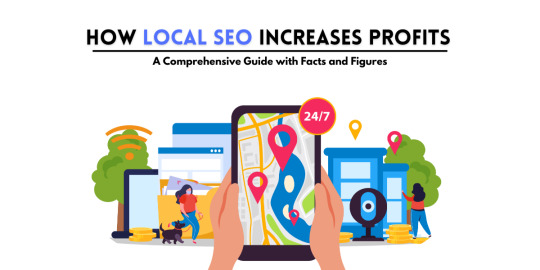
In today's digital landscape, businesses must leverage every tool available to stay competitive. Local SEO (Search Engine Optimization) is one of the most effective strategies for attracting customers in your geographic area. This comprehensive guide will explore how Local SEO can significantly enhance your profits, backed by facts and figures, and provide actionable tips to boost your local search presence.
What is Local SEO?
Local SEO focuses on optimizing a business's online presence to attract customers from specific localities. This includes appearing in local search results, Google Maps, and the coveted Google Local Pack.
Why is Local SEO Important?
Increased Visibility
Fact: 46% of all Google searches seek local information.
Figure: Businesses that optimize for local SEO can see a 14% increase in web traffic.
Higher Conversion Rates
Fact: 78% of mobile local searches result in an offline purchase.
Figure: Local searches contribute to 28% of all purchases.
Cost-Effective Marketing
Local SEO targets users actively seeking your services, leading to a lower cost per acquisition.
Key Components of Local SEO
1. Google My Business (GMB) Optimization
Claim and Verify Your Listing: Ensure that your GMB profile is active and verified.
Consistent Information: Keep your business name, address, and phone number (NAP) accurate across all platforms.
Engagement: Update your GMB listing with posts, photos, and promotions to engage customers.
2. Local Keywords
Keyword Research: Identify local search terms relevant to your business.
Implementation: Use these keywords in your website content, meta tags, and GMB listing.
3. On-Page SEO
Title Tags and Meta Descriptions: Optimize these elements with local keywords.
Schema Markup: Use schema to help search engines understand your business details.
4. Customer Reviews
Encouragement: Prompt satisfied customers to leave reviews on your GMB and other review platforms.
Response Strategy: Engage with all reviews—both positive and negative—to demonstrate that you value customer feedback.
5. Local Backlinks
Relationship Building: Network with local businesses and influencers to earn backlinks.
Community Engagement: Participate in local events or sponsorships to increase exposure and credibility.
Tips and Tricks to Boost Local SEO
Leverage Social Media: Share local content, promotions, and events to drive traffic and engagement.
Optimize for Mobile: Ensure your website is mobile-friendly, as a significant portion of local searches occurs on mobile devices.
Create Location-Specific Content: Develop blogs, guides, or resources that cater to local interests and events.
Use Local Citations: List your business in local directories like Yelp and Yellow Pages with consistent NAP information.
Monitor Analytics: Use Google Analytics and Google Search Console to track performance and refine your strategy.
Facts and Figures Supporting Local SEO Success
Search Engine Behavior: 88% of consumers who conduct a local search visit a related business within a day.
Consumer Trust: 92% of consumers trust online reviews as much as personal recommendations.
Mobile Searches: 76% of people who search for something nearby visit a business within a day.
Conclusion
Investing in Local SEO is essential for businesses looking to enhance their visibility and increase profits. By optimizing your online presence, focusing on local keywords, managing customer reviews, and building local backlinks, you can develop a strong local marketing strategy that drives business growth.
#Local SEO#Search Engine Optimization#Local search marketing#Google My Business#Local visibility#Local keywords#Local citations
1 note
·
View note
Text
Top 10 Laravel Development Companies in the USA in 2024
Laravel is a widely-used open-source PHP web framework designed for creating web applications using the model-view-controller (MVC) architectural pattern. It offers developers a structured and expressive syntax, as well as a variety of built-in features and tools to enhance the efficiency and enjoyment of the development process.

Key components of Laravel include:
1. Eloquent ORM (Object-Relational Mapping): Laravel simplifies database interactions by enabling developers to work with database records as objects through a powerful ORM.
2. Routing: Laravel provides a straightforward and expressive method for defining application routes, simplifying the handling of incoming HTTP requests.
3. Middleware: This feature allows for the filtering of HTTP requests entering the application, making it useful for tasks like authentication, logging, and CSRF protection.
4. Artisan CLI (Command Line Interface): Laravel comes with Artisan, a robust command-line tool that offers commands for tasks such as database migrations, seeding, and generating boilerplate code.
5. Database Migrations and Seeding: Laravel's migration system enables version control of the database schema and easy sharing of changes across the team. Seeding allows for populating the database with test data.
6. Queue Management: Laravel's queue system permits deferred or background processing of tasks, which can enhance application performance and responsiveness.
7. Task Scheduling: Laravel provides a convenient way to define scheduled tasks within the application.
What are the reasons to opt for Laravel Web Development?
Laravel makes web development easier, developers more productive, and web applications more secure and scalable, making it one of the most important frameworks in web development.
There are multiple compelling reasons to choose Laravel for web development:
1. Clean and Organized Code: Laravel provides a sleek and expressive syntax, making writing and maintaining code simple. Its well-structured architecture follows the MVC pattern, enhancing code readability and maintainability.
2. Extensive Feature Set: Laravel comes with a wide range of built-in features and tools, including authentication, routing, caching, and session management.
3. Rapid Development: With built-in templates, ORM (Object-Relational Mapping), and powerful CLI (Command Line Interface) tools, Laravel empowers developers to build web applications quickly and efficiently.
4. Robust Security Measures: Laravel incorporates various security features such as encryption, CSRF (Cross-Site Request Forgery) protection, authentication, and authorization mechanisms.
5. Thriving Community and Ecosystem: Laravel boasts a large and active community of developers who provide extensive documentation, tutorials, and forums for support.
6. Database Management: Laravel's migration system allows developers to manage database schemas effortlessly, enabling version control and easy sharing of database changes across teams. Seeders facilitate the seeding of databases with test data, streamlining the testing and development process.
7. Comprehensive Testing Support: Laravel offers robust testing support, including integration with PHPUnit for writing unit and feature tests. It ensures that applications are thoroughly tested and reliable, reducing the risk of bugs and issues in production.
8. Scalability and Performance: Laravel provides scalability options such as database sharding, queue management, and caching mechanisms. These features enable applications to handle increased traffic and scale effectively.
Top 10 Laravel Development Companies in the USA in 2024
The Laravel framework is widely utilised by top Laravel development companies. It stands out among other web application development frameworks due to its advanced features and development tools that expedite web development. Therefore, this article aims to provide a list of the top 10 Laravel Development Companies in 2024, assisting you in selecting a suitable Laravel development company in the USA for your project.
IBR Infotech

IBR Infotech excels in providing high-quality Laravel web development services through its team of skilled Laravel developers. Enhance your online visibility with their committed Laravel development team, which is prepared to turn your ideas into reality accurately and effectively. Count on their top-notch services to receive the best as they customise solutions to your business requirements. Being a well-known Laravel Web Development Company IBR infotech is offering the We provide bespoke Laravel solutions to our worldwide customer base in the United States, United Kingdom, Europe, and Australia, ensuring prompt delivery and competitive pricing.
Additional Information-
GoodFirms : 5.0
Avg. hourly rate: $25 — $49 / hr
No. Employee: 10–49
Founded Year : 2014
Verve Systems
Elevate your enterprise with Verve Systems' Laravel development expertise. They craft scalable, user-centric web applications using the powerful Laravel framework. Their solutions enhance consumer experience through intuitive interfaces and ensure security and performance for your business.
Additional Information-
GoodFirms : 5.0
Avg. hourly rate: $25
No. Employee: 50–249
Founded Year : 2009
KrishaWeb

KrishaWeb is a world-class Laravel Development company that offers tailor-made web solutions to our clients. Whether you are stuck up with a website concept or want an AI-integrated application or a fully-fledged enterprise Laravel application, they can help you.
Additional Information-
GoodFirms : 5.0
Avg. hourly rate: $50 - $99/hr
No. Employee: 50 - 249
Founded Year : 2008
Bacancy
Bacancy is a top-rated Laravel Development Company in India, USA, Canada, and Australia. They follow Agile SDLC methodology to build enterprise-grade solutions using the Laravel framework. They use Ajax-enabled widgets, model view controller patterns, and built-in tools to create robust, reliable, and scalable web solutions
Additional Information-
GoodFirms : 4.8
Avg. hourly rate: $25 - $49/hr
No. Employee: 250 - 999
Founded Year : 2011
Elsner
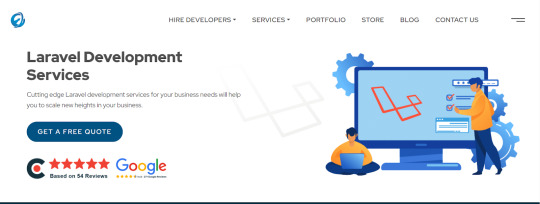
Elsner Technologies is a Laravel development company that has gained a high level of expertise in Laravel, one of the most popular PHP-based frameworks available in the market today. With the help of their Laravel Web Development services, you can expect both professional and highly imaginative web and mobile applications.
Additional Information-
GoodFirms : 5
Avg. hourly rate: < $25/hr
No. Employee: 250 - 999
Founded Year : 2006
Logicspice

Logicspice stands as an expert and professional Laravel web development service provider, catering to enterprises of diverse scales and industries. Leveraging the prowess of Laravel, an open-source PHP framework renowned for its ability to expedite the creation of secure, scalable, and feature-rich web applications.
Additional Information-
GoodFirms : 5
Avg. hourly rate: < $25/hr
No. Employee: 50 - 249
Founded Year : 2006
Sapphire Software Solutions
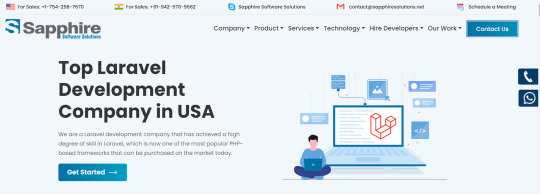
Sapphire Software Solutions, a leading Laravel development company in the USA, specialises in customised Laravel development, enterprise solutions,.With a reputation for excellence, they deliver top-notch services tailored to meet your unique business needs.
Additional Information-
GoodFirms : 5
Avg. hourly rate: NA
No. Employee: 50 - 249
Founded Year : 2002
iGex Solutions
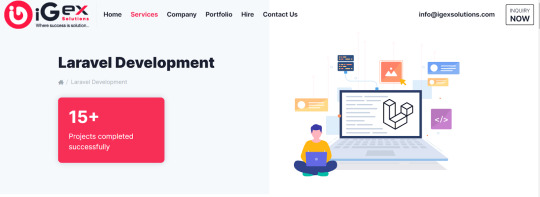
iGex Solutions offers the World’s Best Laravel Development Services with 14+ years of Industry Experience. They have 10+ Laravel Developer Experts. 100+ Elite Happy Clients from there Services. 100% Client Satisfaction Services with Affordable Laravel Development Cost.
Additional Information-
GoodFirms : 4.7
Avg. hourly rate: < $25/hr
No. Employee: 10 - 49
Founded Year : 2009
Hidden Brains
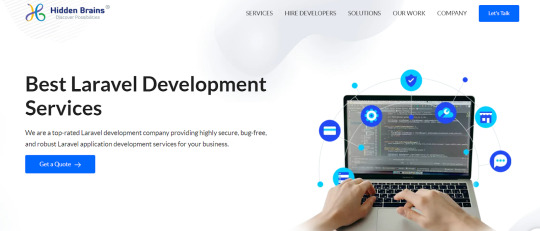
Hidden Brains is a leading Laravel web development company, building high-performance Laravel applications using the advantage of Laravel's framework features. As a reputed Laravel application development company, they believe your web application should accomplish the goals and can stay ahead of the rest.
Additional Information-
GoodFirms : 4.9
Avg. hourly rate: < $25/hr
No. Employee: 250 - 999
Founded Year : 2003
Matellio
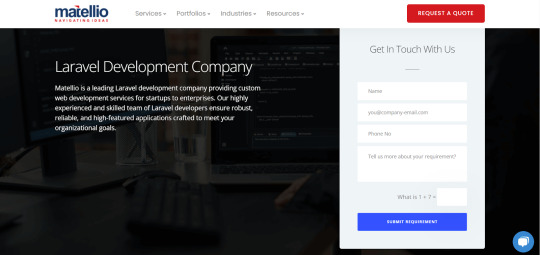
At Matellio, They offer a wide range of custom Laravel web development services to meet the unique needs of their global clientele. There expert Laravel developers have extensive experience creating robust, reliable, and feature-rich applications
Additional Information-
GoodFirms : 4.8
Avg. hourly rate: $50 - $99/hr
No. Employee: 50 - 249
Founded Year : 2014
What advantages does Laravel offer for your web application development?
Laravel, a popular PHP framework, offers several advantages for web application development:
Elegant Syntax
Modular Packaging
MVC Architecture Support
Database Migration System
Blade Templating Engine
Authentication and Authorization
Artisan Console
Testing Support
Community and Documentation
Conclusion:
I hope you found the information provided in the article to be enlightening and that it offered valuable insights into the top Laravel development companies.
These reputable Laravel development companies have a proven track record of creating customised solutions for various sectors, meeting client requirements with precision.
Over time, these highlighted Laravel developers for hire have completed numerous projects with success and are well-equipped to help advance your business.
Before finalising your choice of a Laravel web development partner, it is essential to request a detailed cost estimate and carefully examine their portfolio of past work.
#Laravel Development Companies#Laravel Development Companies in USA#Laravel Development Company#Laravel Web Development Companies#Laravel Web Development Services
2 notes
·
View notes
Text
Elevating Your Full-Stack Developer Expertise: Exploring Emerging Skills and Technologies
Introduction: In the dynamic landscape of web development, staying at the forefront requires continuous learning and adaptation. Full-stack developers play a pivotal role in crafting modern web applications, balancing frontend finesse with backend robustness. This guide delves into the evolving skills and technologies that can propel full-stack developers to new heights of expertise and innovation.

Pioneering Progress: Key Skills for Full-Stack Developers
1. Innovating with Microservices Architecture:
Microservices have redefined application development, offering scalability and flexibility in the face of complexity. Mastery of frameworks like Kubernetes and Docker empowers developers to architect, deploy, and manage microservices efficiently. By breaking down monolithic applications into modular components, developers can iterate rapidly and respond to changing requirements with agility.
2. Embracing Serverless Computing:
The advent of serverless architecture has revolutionized infrastructure management, freeing developers from the burdens of server maintenance. Platforms such as AWS Lambda and Azure Functions enable developers to focus solely on code development, driving efficiency and cost-effectiveness. Embrace serverless computing to build scalable, event-driven applications that adapt seamlessly to fluctuating workloads.
3. Crafting Progressive Web Experiences (PWEs):
Progressive Web Apps (PWAs) herald a new era of web development, delivering native app-like experiences within the browser. Harness the power of technologies like Service Workers and Web App Manifests to create PWAs that are fast, reliable, and engaging. With features like offline functionality and push notifications, PWAs blur the lines between web and mobile, captivating users and enhancing engagement.
4. Harnessing GraphQL for Flexible Data Management:
GraphQL has emerged as a versatile alternative to RESTful APIs, offering a unified interface for data fetching and manipulation. Dive into GraphQL's intuitive query language and schema-driven approach to simplify data interactions and optimize performance. With GraphQL, developers can fetch precisely the data they need, minimizing overhead and maximizing efficiency.

5. Unlocking Potential with Jamstack Development:
Jamstack architecture empowers developers to build fast, secure, and scalable web applications using modern tools and practices. Explore frameworks like Gatsby and Next.js to leverage pre-rendering, serverless functions, and CDN caching. By decoupling frontend presentation from backend logic, Jamstack enables developers to deliver blazing-fast experiences that delight users and drive engagement.
6. Integrating Headless CMS for Content Flexibility:
Headless CMS platforms offer developers unprecedented control over content management, enabling seamless integration with frontend frameworks. Explore platforms like Contentful and Strapi to decouple content creation from presentation, facilitating dynamic and personalized experiences across channels. With headless CMS, developers can iterate quickly and deliver content-driven applications with ease.
7. Optimizing Single Page Applications (SPAs) for Performance:
Single Page Applications (SPAs) provide immersive user experiences but require careful optimization to ensure performance and responsiveness. Implement techniques like lazy loading and server-side rendering to minimize load times and enhance interactivity. By optimizing resource delivery and prioritizing critical content, developers can create SPAs that deliver a seamless and engaging user experience.
8. Infusing Intelligence with Machine Learning and AI:
Machine learning and artificial intelligence open new frontiers for full-stack developers, enabling intelligent features and personalized experiences. Dive into frameworks like TensorFlow.js and PyTorch.js to build recommendation systems, predictive analytics, and natural language processing capabilities. By harnessing the power of machine learning, developers can create smarter, more adaptive applications that anticipate user needs and preferences.
9. Safeguarding Applications with Cybersecurity Best Practices:
As cyber threats continue to evolve, cybersecurity remains a critical concern for developers and organizations alike. Stay informed about common vulnerabilities and adhere to best practices for securing applications and user data. By implementing robust security measures and proactive monitoring, developers can protect against potential threats and safeguard the integrity of their applications.
10. Streamlining Development with CI/CD Pipelines:
Continuous Integration and Deployment (CI/CD) pipelines are essential for accelerating development workflows and ensuring code quality and reliability. Explore tools like Jenkins, CircleCI, and GitLab CI/CD to automate testing, integration, and deployment processes. By embracing CI/CD best practices, developers can deliver updates and features with confidence, driving innovation and agility in their development cycles.
#full stack developer#education#information#full stack web development#front end development#web development#frameworks#technology#backend#full stack developer course
2 notes
·
View notes
Text
Let's talk about Axiom Schema of Replacement.
To start from the beginning: what's ZFC for?
Whenever we're doing any kind of math, we want to say that things exist. To build objects from nothing or from other objects, to use obviously definable functions, to locate subobjects with properties, and to.....not really care about proving their....fairly obvious existence.
ZFC gives us tools for exactly that! It claims existence of all kinds of things. —well, ok, really it claims existence of exactly one kind of thing — sets — but most anything can be encoded as a set, and by golly there are sets in ZFC.
Now, some amount of design went into ZFC, and its axioms are, to an extent, individually ≈compact in ≈scope of objects they provide, and all have a ≈well-defined purpose. There's Pair if we want to build a set by concretely pointing at its objects; there's Union when we want, well, a union over a collection; there's Infinity when we're not satisfied with finite objects; there's Powerset when we want e.g. functions to exist as first-class objects.
However: while these axioms are very generally useful, they're not very suited to constructing.....objects of specific weird shapes. To get these, we want the full expressive power of first-order-logic formulas, and therefore, Axiom Schemas.
ZFC has two.
---
Axiom Schema of Restricted Comprehension (also: of Specification) is probably extremely familiar! It's the axiom that validates the set-builder notation, { x ∈ A | φ(x) }; it lets us take any set and acquire its subset filtered by any formula. Very useful! However, it's only usable if we can construct an overset that definitely contains everything we need. What if we can't?
Concrete example: let ω be the name of the standard countable set, and consider iterated powersets of ω: ω, 𝓟(ω), 𝓟(𝓟(ω)), ..., 𝓟ⁿ(ω), ... . Is there a union of all of these? Union would give us that if we managed to construct the set {ω, 𝓟(ω), 𝓟(𝓟(ω)), ..., 𝓟ⁿ(ω), ...}, but, while all individual 𝓟ⁿ(ω) definitely exist by iterated application of Powerset, it's not clear how'd we collect them all into a set.
---
On a completely unrelated topic¹, let's talk about two concepts of a function.
(¹ blatant lie)
One way to define a function is to exhibit a set that represents it, i.e. contains pairs (x, y) with x ∈ X and y ∈ Y, and also exactly one such pair for every x from X.
Another way to define a function is through a predicate. if we imagine a 2-variable formula φ(x, y), for which our ambient theory proves ∀ x. ∃! y. φ(x, y) — that, for any value of the first-argument `x` exactly one value `y` of the second-argument satisfies φ — then it's reasonable to say that φ defines a function! We can, in principle, plug any given `x` into the proof of ∀ x. ∃! y. φ(x, y), and extract the `y` that the proof demonstrates, linked to `x` fairly functionally.
It's easy to see that any set-function can be converted into a formula-function: if we're given an f : X → Y, then φ(x, y) := (x,y) ∈ f trivially "defines" the same "function" as f!
To convert a functional predicate into a set-function, we'll need the Axiom Schema of Replacement.
---
Slightly simplifying, Axiom Schema of Replacement says:
- given a formula φ(x,y),
- a codomain X from which we'll pull x-arguments to φ,
- and a proof that this formula is in fact functional on X,
- there exists the set Y collecting all the `y`s that satisfy φ for `x`s from X.
Or, formally: ∀ X. [∀ x ∈ X ∃! y. φ(x, y)] ⟹ ∃ Y ∀ y. [y ∈ Y ⟺ ∃ x ∈ X . φ(x, y)].
(In fact, φ is allowed to have other free variables, and also to depend on X, but, eh, details.)
With that, we can convert formulas into functions! Take a φ and a codomain X; acquire the domain Y via Replacement, construct the product X×Y the usual way, then filter it via Comprehension to {(x,y) ∈ X×Y | φ(x, y)}, and there we have it.
To answer our previous question: the union of 𝓟ⁿ(ω) certainly exists! we can construct a formula φ(n, S) that's satisfied exactly when S = 𝓟ⁿ(ω), then acquire the image of ω under φ via Replacement, and union over the resulting { 𝓟ⁿ(ω) | n ∈ ω }.
(There's a trick to constructing that φ, but that's a topic for another post.)
6 notes
·
View notes